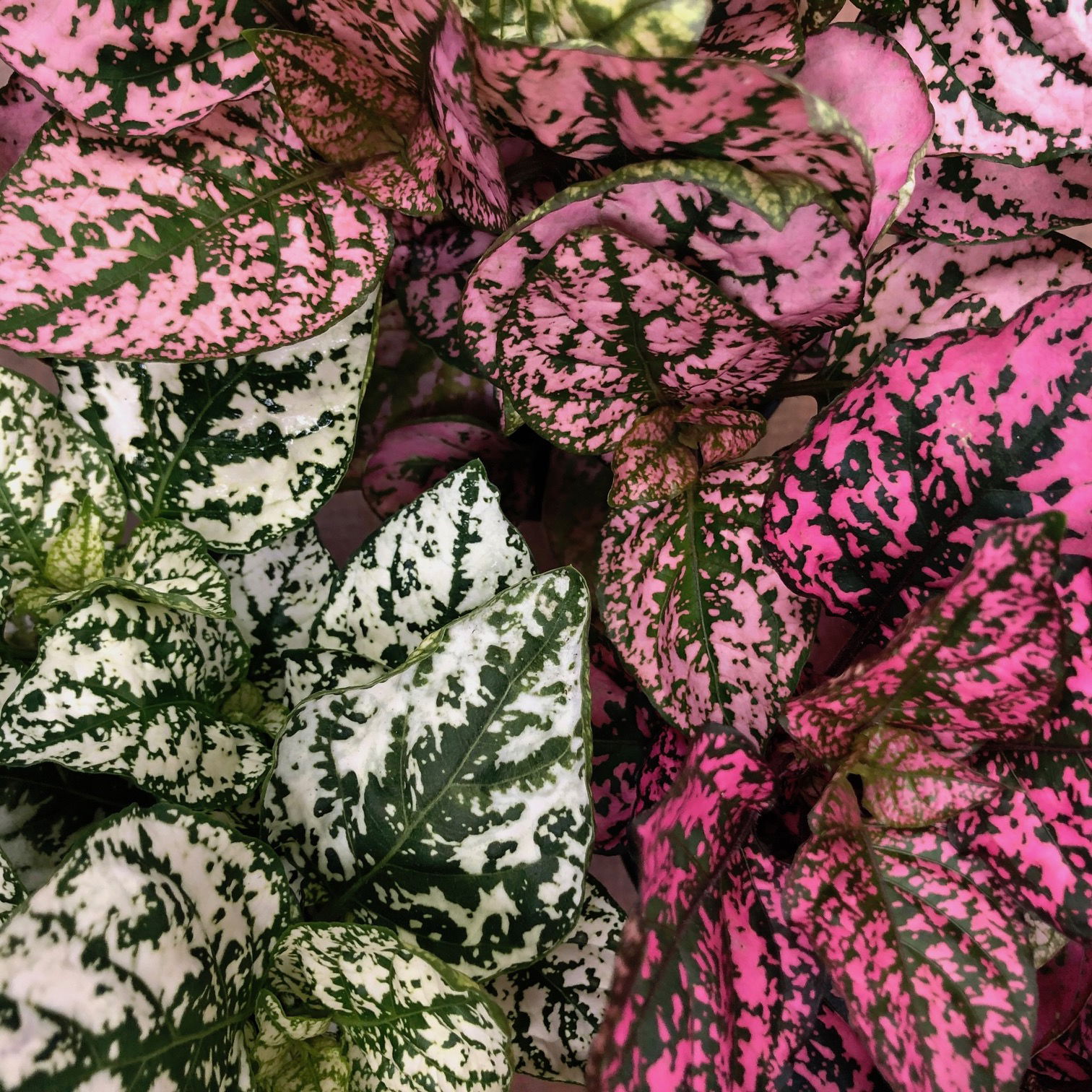
Hypoestes phyllostachya
Contents
- Top Tips
- Location, Water, Humidity & Fertilisation
- Common Issues
- Origins, Temperature, Propagation, Repotting & Toxicity
Are you struggling to find the answer to your specific plant issue? Book a 1-to-1 video call with THE HOUSEPLANT DOCTOR™, the website's friendly author, to put an end to your stress today! Available on iMessage, WhatsApp, Facebook Messenger & more.
Top Tips & Info
- Care Difficulty - Easy
- Present a bright, indirect setting for good quality growth. Avoid direct sunlight at all costs to prevent the risk of sun-scorch.
- Water once the top inch dries out, reducing this slightly further in the autumn and winter.
- Average room humidity is acceptable, but introduce a pebble tray while the heaters are operating.
- Fertilise using a 'Houseplant' labelled feed every four waters in the spring and summer, reducing this to every six water in the colder months.
- If the foliage crisps up, scroll down to 'Common Issues' for more information and advice.
- Repot every three years using a slightly water-retentive soil, for instance, 'Houseplant' labelled compost, which you can purchase at any good garden centre.
- 'Tot' specimens in a 5cm pot are great for tropical-themed terrariums or displays due to the tall growth habits, giving yours a feeling of 'height'.
Location & Light - 🔸🔸
Polka Dot Plants are best located in bright, indirect light where a newspaper can be read without the use of artificial lighting. As the species originates from the jungle floor across tropical locations in Madagascar, they can tolerate shadier locations better than most plants.
Remember - The amount of light and current season of the year will directly govern the frequencies of waters per month. Specimens placed in shadier areas must be kept on the drier side to life, whereas brighter locations will require more soil moisture to lubricate photosynthesis.
Water - 🔸🔸🔸
Only allow the top inch to dry out in between waters, reducing this slightly further in the autumn and winter. Although Polka Dot Plants will dramatically wilt if they endure short periods of droughts, it's usually harmless and should bounce back after several hours if the foliage is functioning still. Under-watering symptoms include a bare stem with little or no remaining leaves & stunted growth. These are commonly down to either forgetfulness or intense sunlight; scroll down to 'Common Issues' for more information. Over-watering symptoms include the rapid yellowing of lower leaves, soil mould and a rotten stem. Make sure your plant is situated in a brighter environment with slightly fewer irrigations if this is the case. Never tinker with the roots unless wholly necessary during a repot as it could cause transplant shock and eventual death.
Humidity - 🔸🔸🔸
Although average room humidity is enough for this species, high humidity will slow the rate of drying soil and dehydration considerably. Introduce a pebble tray to improve its surrounding environment while the heaters are operating in the autumn and winter.
Fertilisation - 🔸
Supplement using a 'Houseplant' labelled feed every four waters during the growing period and every six for the rest of the year. Never over-supplement in the dormancy period as it'll lead to the root-burn with yellowed leaves and spindly growth.
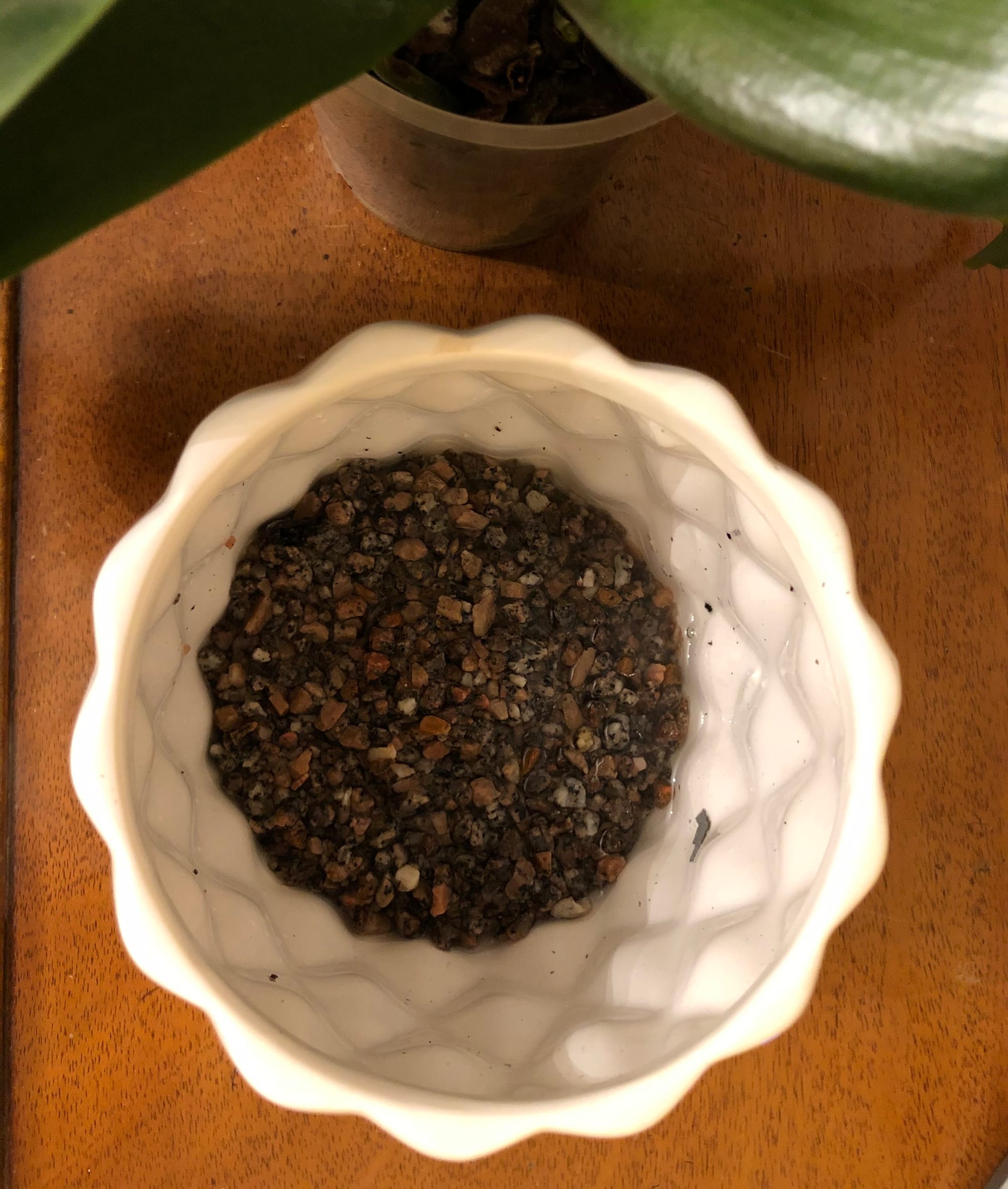 If you're forgetful with watering or battling with dry air, why not fill the decorative pot's bottom sixth with small grit? This will promote more reliable soil moisture that'll help encourage better growth & all-round health as the excess moisture will drain from the plant's plastic pot, thus creating a humid environment for root interaction.
If you're forgetful with watering or battling with dry air, why not fill the decorative pot's bottom sixth with small grit? This will promote more reliable soil moisture that'll help encourage better growth & all-round health as the excess moisture will drain from the plant's plastic pot, thus creating a humid environment for root interaction.
Common Issues with Polka Dot Plants
When a Polka Dot Plant is severely dehydrated, most of its leaves will crisp-up and fall off - leaving you with a naked plant. Although it may spell the end of juvenile plantlets, there may still be light at the end of the tunnel for more established specimens. If its stem is still plump without any signs of retraction, prune-away the seriously affected areas and contain the plant (with its pot) in a transparent bag that has small holes. Keep the soil continually moist, providing a good level of indirect light and temperatures above 15°C (59°F). After a few weeks, new life will form in the nodal junctions on the stems, signalling the start of its recovery process. Maintain a sealed environment for the following month until you feel it's necessary to release it back into the open air. For the prevention of environmental shock, be sure to introduce a humidity tray for higher levels of atmospheric moisture around the plant in its new setting. Not only will this ease the specimen back into normal functioning life, but it'll also reduce the rate of transpiration (water-loss in the leaves), and therefore downplay the risk of dehydration and further decline.
Mould or mushrooms developing on the soil means two things - too little light and over-watering. Despite the harmlessness, it'll prove unsightly to most gardeners and is therefore removed once known. To remove, replace the top two inches of the soil for a fresh batch of 'Houseplant' compost or a coconut-coir based product. Either increase the amount of light received (no direct sunlight for the first few weeks to prevent environmental shock) or decrease the frequency of waters slightly. If the mould is accompanied by yellowing lower leaves, you may also have a case of root rot.
Too low humidity can cause browning tips with yellow halos on juvenile leaves. Although this won't kill your specimen, you may want to increase the local moisture to prevent the new growth from adopting these symptoms. Mist or rinse the foliage from time to time and create a humidity tray while the heaters are active to create a stable environment. Browning leaf tips are an inevitable part of a leaf's maturity though, so never be too disheartened if your specimen is showing signs of this!
Yellowing lower leaves (closest to soil) could be a sign of over-watering, but equally is a byproduct of maturity. If the older leaves rapidly become yellow in quick succession, over-watering could be to blame. People don't realise that a plant's root system needs access to oxygen too; when soil is watered, the air will travel upwards and out of the potting mix. A lack of accessible oxygen for the roots will cause them to subsequently breakdown over the oncoming days. Click on this link to learn more about root rot and how to address it.
Curled leaves and brown leaf-edges are the result of too little water and over-exposure to the sun. Polka Dot Plants are best located in bright, indirect settings, and those that haven't acclimatised to the harsh rays will show signs of sun-scorch and environmental shock. A splash of winter sunlight is acceptable as long as the soil moisture is regularly observed, with complete avoidance once summer comes along.
A loss of variegations is caused by too little light. Although Polka Dot Plants is an excellent choice for shady locations, it'll come at the cost of its variegations. Move the plant into a brighter area with minimal direct sunlight to allow the variegations to appear on the new growth. Alternatively, extreme variegations that hinder the plant from developing chlorophyll (green pigmentation) is typically caused by too much sunlight.
Small flies hovering around your plant is entirely natural and may just indicate you're watering a little too often. Fungus Gnats are a common 'pest' with Polka Dot Plants due to their dependency to reliable soil moisture, but won't pose any risk to the plant's health. Simply replace the top quarter of the plant's potting mix for a fresh batch of 'Houseplant' labelled compost, typical found at most garden centres.
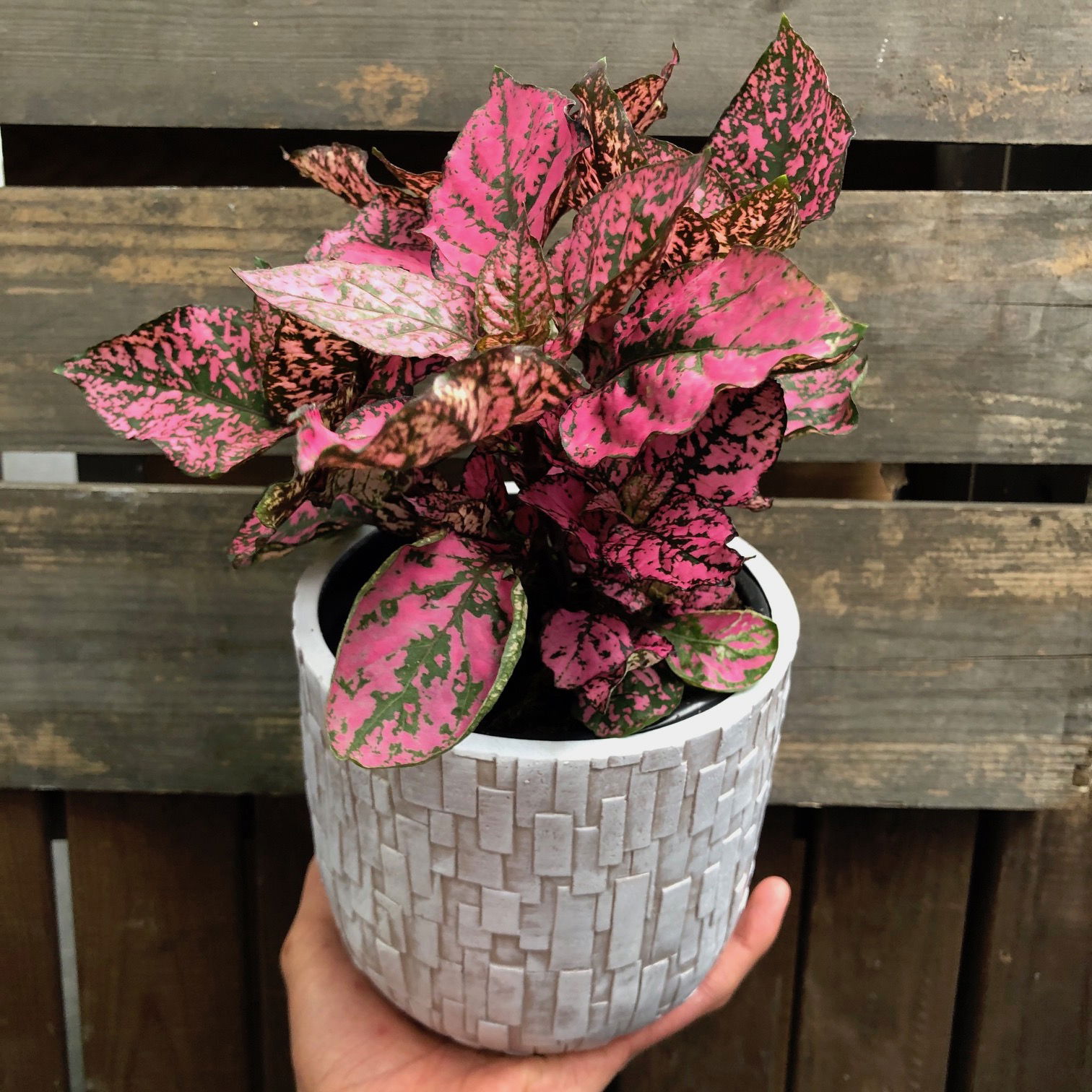 Polka Dot Plants are a distant cousin to the Nerve Plants, who both form part of the Acanthaceæ family.
Polka Dot Plants are a distant cousin to the Nerve Plants, who both form part of the Acanthaceæ family.
Origins
John Baker first described the species in 1887, using the Latin specific epithet 'phyllostachya', “with a leaf spike", which is in reference to the foliar structure. The name, Hypoestes, comes from the Greek 'hypo' translating to under and 'estia' meaning house, which refers to the hidden flowers under the fused bracts.
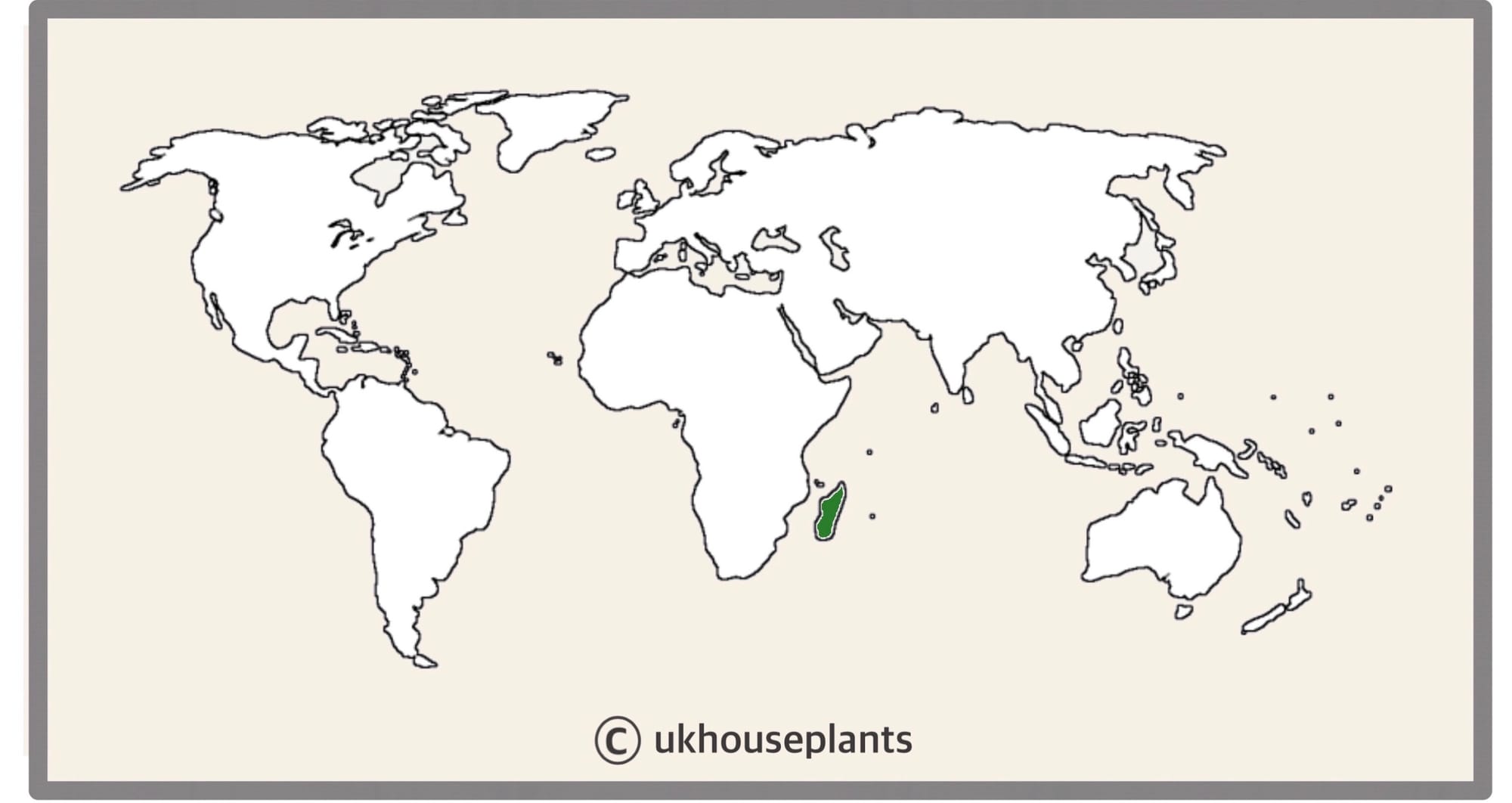 The Distribution of Hypoestes phyllostachya
The Distribution of Hypoestes phyllostachya
Temperature
12° - 24°C (54° - 75°F)
H1b (Hardiness Zone 12) - Can be grown outdoors during the summer in a sheltered location with temperatures above 12℃ (54℉), but is fine to remain indoors, too. If you decide to bring this plant outdoors, don't allow it to endure any direct sunlight as it may result in sun-scorch and dehydration. Regularly keep an eye out for pests, especially when re-introducing it back indoors.
Spread
Up to 0.3m (12 inches) in height and 0.6m (24 inches) in width once it reach maturity. The ultimate height will take between 3 - 5 years to achieve when repotted biannually.
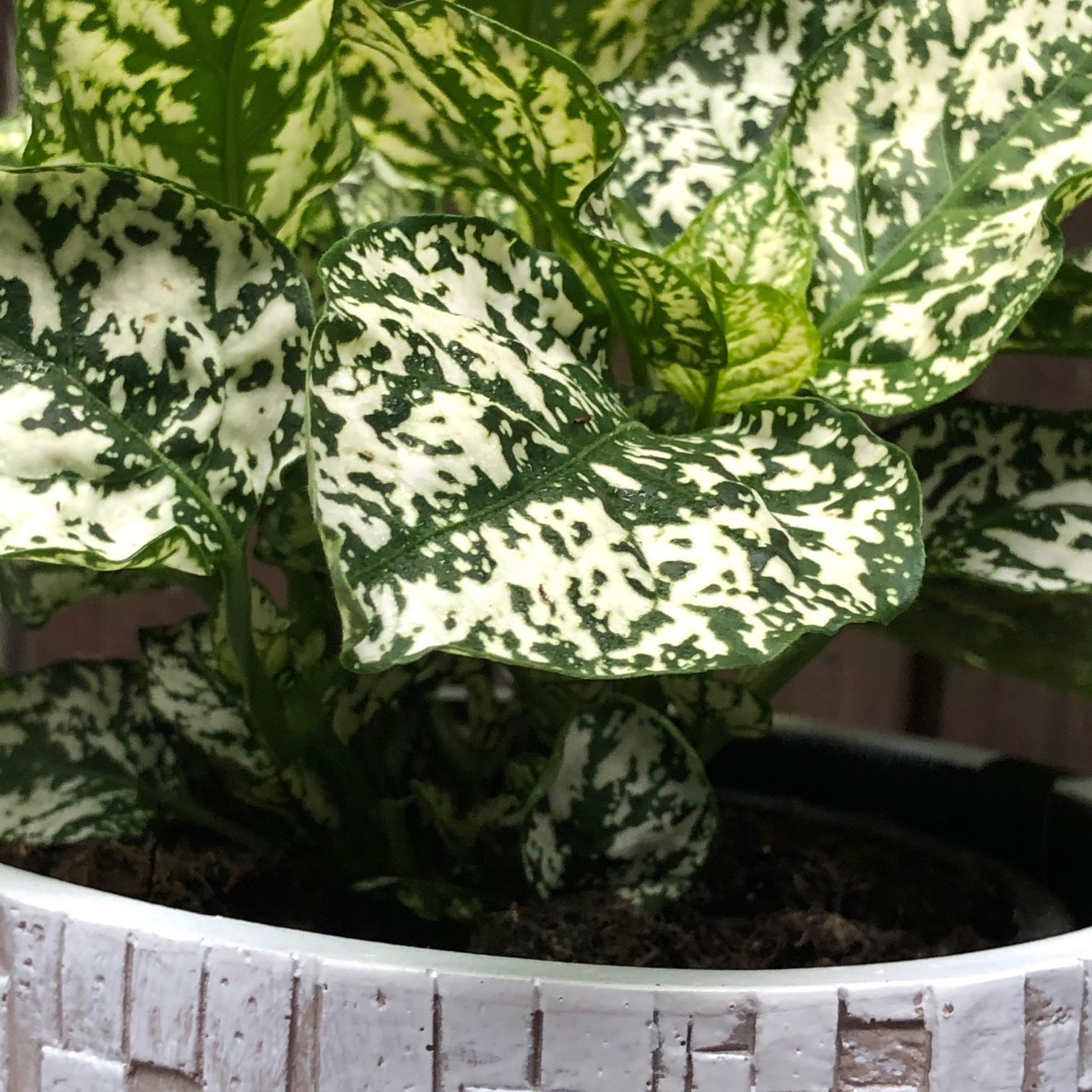 Polka Dot Plants are a fantastic plant to have in one's collection due to the stunning foliage and easy-care retirements.
Polka Dot Plants are a fantastic plant to have in one's collection due to the stunning foliage and easy-care retirements.
Pruning & Maintenance
Remove yellow or dying leaves, and plant debris to encourage better-growing conditions. While pruning, always either clean scissors to reduce the chance of bacterial diseases, or pinch the leading growths off to promote a bushier appearance. Never cut through yellowed tissue as this may cause further damage in the likes of diseases or bacterial infections. Remember to make clean incisions as too-damaged wounds may shock the plant, causing weakened growth and a decline in health.
Propagation
Via Seed, Division or Stem Cuttings.
Division (Easy) - Split the root ball into several sections during the start of spring. Dividing too-small segments of the rootball could lead to transplant shock or unsuccessful propagation. Sections that are at least 5cm (2 inches) in diameter serve the best chance of propagation due to the stored energy in the roots and stems. Place the sections into 'Houseplant' compost and water regularly, avoiding prolonged sunlight or persistent droughts.
Stem Cuttings (Moderate) - This propagation method can be taken from spring to late summer, using between three to five leaves, with a stem length of 5cm (2 inches). Cut directly below a node using a clean knife to reduce bacteria count and remove the older 50% of the leaves. Dip the wound in some rooting hormone before setting it into a well-draining potting mix, for example, a 'Houseplant' labelled compost. Blackleg can occur when the bottom wound becomes infected, typically caused by water-logging or a too-damaged wound. Maintain bright light and evenly moist soil with the avoidance of direct sunlight or cold draughts. Wrap the pot (& foliage) in a transparent bag or within a miniature greenhouse, and provide bottom hear of temperatures above 18°C (54°F). Remove the bag after a month and maintain the same cultivation. Follow the care advice mentioned in the article's top half. This method will take up to three months, so patience and the correct environment are paramount for success!
Flowers
During late spring, Polka Dot Plants will produce small pink or purple spikes up to 20cm (8cm inches) that are situated in the stems' nodal junctions. Your specimen may flower in the height of summer if there's a difference of 8°C between the previous winter and current summer's temperature during the day.
Repotting
Repot every two years in the spring, using a 'Houseplant' labelled compost and the next sized pot with adequate drainage. As Polka Dot Plants are ground creepers, they tend to grow quicker in a wide, shallow pot; visit your local garden centre and search for 'Terracotta Bulb Bowls' which should be on sale all year round. Hydrate the plant 24hrs before tinkering with the roots to prevent the risk of transplant shock. For those that are situated in a darker location, add a thin layer of small grit in the pot's base to improve drainage and downplay over-watering. Click here for a detailed step-by-step guide on transplantation, or via this link to learn about repotting with root rot.
Book a 1-to-1 video call with THE HOUSEPLANT DOCTOR™ if you'd like a personal guide to repotting your houseplant. This will include recommending the right branded-compost and pot size, followed by a live video call whilst you transplant the specimen for step-by-step guidance and answer any further questions!
Pests & Diseases
Keep an eye out for mealybugs, aphids, spider mites, thrips, blackfly, vine weevils & root mealybugs that'll located themselves in the plant's cubbyholes, with the exception of the latter two in soil. Typical diseases associated with Polka Dot Plants are root rot, leaf-spot diseases, rust, southern blight and powdery mildew - click here to learn more about these issues.
Toxicity
Not known to be poisonous when consumed by pets or humans; if high quantities are eaten, it may result in vomiting, nausea and a loss of appetite.
Retail Locations
Blue Diamond, Dobbies & Online Stores.
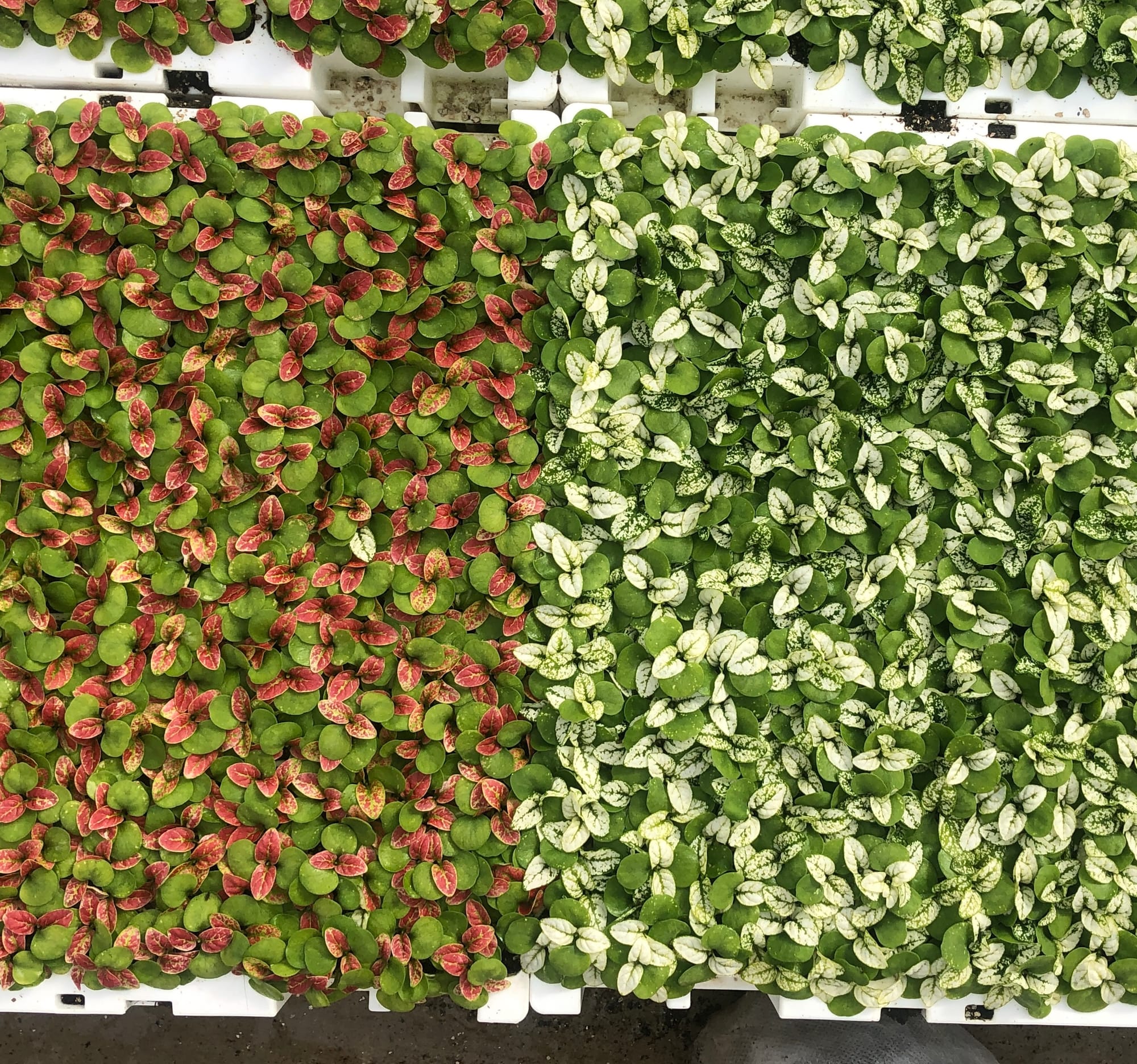 Extra Photo: Polka Dot Plants (Hypoestes) are commercially grown from seed, similarly to the Cheese Plant (Monstera) or Indoor Palm! The plants above are around two months old at this point.
Extra Photo: Polka Dot Plants (Hypoestes) are commercially grown from seed, similarly to the Cheese Plant (Monstera) or Indoor Palm! The plants above are around two months old at this point.
Book a 1-to-1 Call with THE HOUSEPLANT DOCTOR™
If you need further advice with your houseplants, book an advice call with ukhouseplants' friendly and expert writer today! This can be done via a video or audio call on most apps, including Facebook, FaceTime & Skype. A ten-minute call costs £5.99 (US$7), or £15.99 for thirty minutes. You can ask multiple questions, including queries on plants, pests, terrariums, repotting advice and anything in between. Please consider supporting this service to keep ukhouseplants thriving!